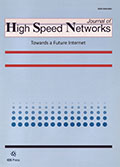Authors: Freire, Mário M. | da Silva, Henrique J.A.
Article Type:
Research Article
Abstract:
In this paper, we present an assessment of the blocking performance in wavelength routed chordal ring networks. The performance is focused on chord lengths of w=3, w=N/4, and $w=\sqrt{N}+3$ , being N the number of nodes. It is shown that, in a 100-node chordal ring network, the use of the chord length of w=N/4 instead of w=3 clearly reduces the blocking probability. A reduction of the blocking probability is also observed when the chord length of $w=\sqrt{N}+3$ is used, instead of w=N/4 or w=3. In fact, the blocking probability gain, due to the choice of the chord
…length of $w=\sqrt{N}+3$ instead of w=3, is of the order of 104 for a load per node of 1 Erlang, and of the order of 1010 for a load of 0.1 Erlang, with 16 wavelengths per link in both cases. Concerning the influence of wavelength interchange it is shown that, for low loads per node, the highest blocking gains due to wavelength interchange are obtained with a chord length of 3, and the lowest gains are obtained with a chord length of $w=\sqrt{N}+3$ . However, for higher loads per node an inverse situation is observed. Chordal rings have also been compared with rings and with mesh-torus. This comparison revealed an important feature: very small blocking gains, due to the increase of the nodal degree from 3 (chordal ring with 100 nodes and $w=\sqrt{N}+3)$ to 4 (mesh torus with 100 nodes), were observed. In this case, as the load per node decreases from 5 Erlang to 0.01 Erlang, the variation of the nodal degree gain remains within one order of magnitude for 16 wavelengths per link. Furthermore, small gains were also observed for networks with a larger size (1600 nodes). Thus, if a small blocking performance degradation is allowed, the choice of a chordal ring with $w=\sqrt{N}+3$ , instead of a mesh-torus, leads to a reduction in the number of network links, and hence in the total cable length, since the number of links in a N-node chordal ring is 3×N, and the number of links in a N-node mesh-torus is 4×N.
Show more
Keywords: Optical network, WDM networks, wavelength routing, performance analysis, chordal ring topology
Citation: Journal of High Speed Networks,
vol. 15, no. 4, pp. 415-432, 2006
Price: EUR 27.50





